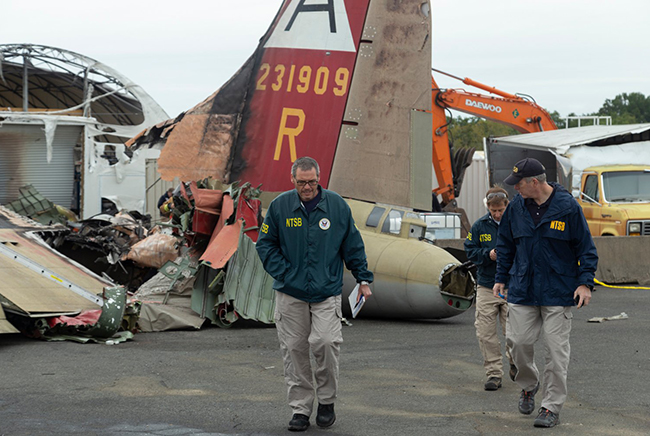
Bob Gretz, National Transportation Safety Board investigator-in-charge, is shown at the site of the B-17 crash at Bradley International Airport in Connecticut. NTSB photo via Twitter.
Seven people are confirmed or presumed dead after a restored World War II-era B-17 crashed Oct. 2, according to Connecticut State Police. An Air National Guardsman aboard the plane is credited for his swift action to help the injured escape the Flying Fortress that was engulfed in flames.
The bomber, nicknamed “Nine-O-Nine,” crashed at around 9:55 a.m. at the Bradley International Airport near Hartford, Conn. The B-17, owned by the nonprofit Collings Foundation, was part of the Wings of Freedom Tour that brought vintage aircraft around the country.
Three crew members and 10 passengers were aboard the aircraft when it crashed. In a statement on its website, the Collings Foundation said it is “fully cooperating with officials to determine the cause of the crash and will comment further when details become known.”
Connecticut State Police on Oct. 3 released the names of those killed, or thought dead, in the crash:
- Pilot Ernest McCauley, 75, of Long Beach, Calif.
- Copilot Michael Foster, 71, of Jacksonville, Fla.
- Passenger David Broderick, 56, of West Springfield, Mass.
- Passenger Gary Mazzone, 66, of Broad Brook, Conn.
- Passenger James Roberts, 48, of Ludlow, Mass.
- Passenger Robert Riddell, 59, of East Granby, Conn.
- Passenger Robert Ruhner, 64, of Tolland, Conn.
One person on the ground in the airport’s de-icing facility was injured in the crash. Six survivors who were on the plane were taken to hospitals.
Among them was an Air National Guardsman who “popped the hatch” of the back of the plane to evacuate the injured after the crash, according to local TV news. Connecticut Adjutant General Maj. Gen. Francis Evon told WTNH that the unnamed Guardsman was “very familiar with the back of an aircraft,” and he was able to “extract some individuals.”
The National Transportation Safety Board shared footage from the crash site. NTSB video via YouTube.
The National Transportation Safety Board has requested inspection and maintenance records for the bomber’s propellers, airframe, and all four engines, an NTSB official said in an Oct. 3 press conference. Preliminary information shows the last major, “continuous airworthiness” inspection took place in January.
“We are aware that the pilot radioed air traffic control and stated there was an issue with one of the engines,” NTSB member Jennifer Homendy said. “We identified that engine in the wreckage and we secured it for further examination.”
Investigators will look into whether any issues were discovered over the course of the B-17’s inspection regimen, as well as dive into training records, a Federal Aviation Administration transcript of the flight crew’s conversations with air traffic control, and related interviews.
Homendy noted that NTSB has investigated the 1940s airframe before, when it overran a Pennsylvania runway in 1987. Its landing gear also failed to deploy once in the 1990s. NTSB has looked into 21 accidents involving WWII-era bombers since 1982, three of which involved B-17Gs—not including the current investigation.
The Air Force Association said Oct. 3 the crash “cost the nation an enduring symbol of the sacrifices and heroism displayed by American airmen” during World War II.
The commitment of the volunteers and the Collings Foundation “set the highest possible standards for our nation to ensure we never forget the sacrifices made by our WWII veterans and airmen,” the association said.
